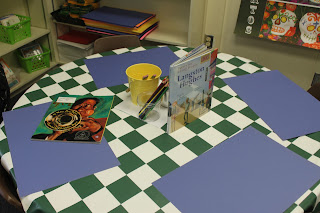Me: What about doing a Café for 4th and 5th graders on the Harlem Renaissance?
Angie: *Pause of silence*
Me: Really, we can pull this off.
Angie is a former high school social studies teacher. Even after nearly two years of running Cafés with me, we surprise each other. She amazes me with how she inspires children to engage in learning, and write amazing poetry. She also has mad decorating skills that would put Martha Stewart to shame. My job - to find the books, brainstorm, and help make the magic happen when the kids come in even when the topic might be a bit of a stretch.
(If you want more information on the hows of our Literacy Cafés, check out my article for Scholastic Book Fair's Newsletter - Bringing Books to Life with Literacy Cafés or my post today over at the Nerdy Book Club. )
Once I convinced her that we didn't need to teach them everything there is to know about the Harlem Renaissance - just give them an introduction - we were off and planning. Our Literacy Café for the Harlem Renaissance was probably one of our biggest endeavors. There was probably 80 hours of planning time for about 9 hours of instructional time. (Don't worry - most of our cafés do not take this much time to plan.)
First, we decided that instead of using a novel, we would use a variety of picture books to start discussion about this time period. Second, we realized that the students needed a pre-teach session prior to the actual Literacy Café. This was something we had never done before but we felt very strongly that they needed some background information on the basics of the Harlem Renaissance and who were some of the key players during that time. Finally, we decided that for the actual Café, we would focus primarily on the poetry of Langston Hughes, and some of the art and music of the time period.
The Pre-Teach Café:
When I did the pre-teach café, I had a few things I wanted all of the students to walk away with. What was the Harlem Renaissance? When did it take place? Why was it important to history? and Who were some of the key individuals of the time period?
Thanks to technology, I was able to bring in audio and video clips that allowed children to hear Langston Hughes or Zora Neale Hurston read and speak about pieces of their work or to listen to the music of some of the greatest jazz musicians or to watch as dancers perform the Lindy Hop.
The Café:
When we did the actual cafe, we decided that we would split the class into two groups. One group would begin inside with Angie. They would look at Langston Hughes' poem - Harlem and then do their own writing response to what they could see or feel from the words of the poem. The other half began outside with me (yes, in Southern California, we can do outdoor teaching in February). I loaded up my iPod with different songs from Louis Armstrong, Duke Ellington, Count Bassie, Ella Fitzgerald, Billie Holiday, and more. We had looked at various pieces of art from painters such as Douglas Aaron and Jacob Lawerence and Archibald Motley and Palmer Hayden. They were to create their own Harlem Renaissance paintings inspired by the music of the time period. After a designated amount of time, we switched groups. At the end, we gathered together for a de-brief while we ate red beans and rice, corn bread and lemonade. (Our school custodian was so excited about what we were doing that he actually made red beans and rice for the kids.)
 |
| Aaron Douglas - Jazz Roots |
What did we learn:
Angie and I are never content to rest on the success of one lesson. We did 3 pre-teach sessions that were all different in order to meet the needs of each group of students that came into the café. This was the same with the actual Cafés. As teachers, if we pay attention to our students, they will show us what we need to learn to better help them learn. For example, we realized after the first session that the students needed assistance in focusing on what they were learning in the pre-teach and so Angie created a note-taking sheet to help all the students. I learned that when children do not have a strong grasp of number lines they often don't have a good understanding of time lines. Along with that, we have done such a good job of teaching about Slavery and Civil Rights that many of the students think it all flows together without seeing that there were years between one thing and the other.
We were also struck by how this Café deeply impacted many of our students who were able to celebrate their own culture and history in a way they had never done before. We also learned that it was worth every hour we had invested into the prep time to make this Café a reality.
I hope that you will consider the possibility of doing your own Café with your students. For more posts on Literacy Cafés, and some of the books we used, type in Literacy Café into the search bar on this blog.









